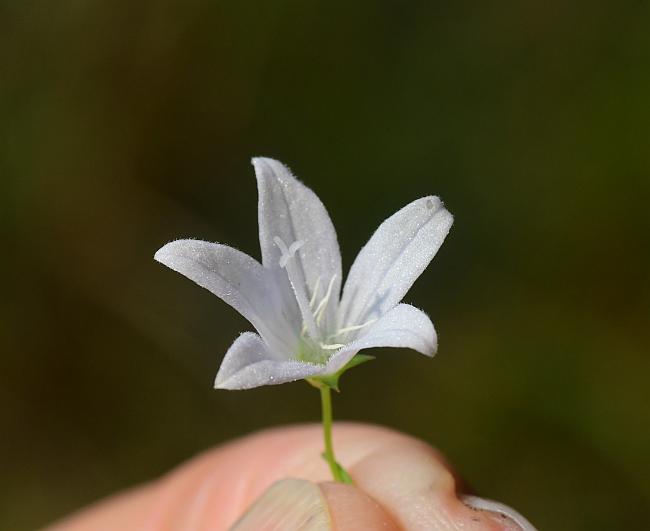Campanula aparinoides Pursh
Marsh Bellflower

Native
CC = 10
CW = -5
MOC = 5
SRank = S1
© SRTurner
Campanula aparinoides PurshMarsh Bellflower | |
 |
Native CC = 10 CW = -5 MOC = 5 SRank = S1 |
© SRTurner |
|
Family - Campanulaceae Habit - Weak, slender perennial herbs, with very shallow roots and sometimes slender rhizomes. Stems - Loosely spreading, often reclining on adjacent plants, to 50 cm, often somewhat 3-angled, roughened with short, recurved hairs, sparingly branched toward the tip.
Leaves - Alternate, simple, sessile, gradually reduced from near the stem base to the tip. Blades 0.6-5.0 cm long, 1-5 mm wide, narrowly lanceolate to linear, angled or tapered at the base, shot-tapered at the tip, with recurved hairs having swollen bases along the margins and midvein, the margins sometimes also with a few minute teeth.
Inflorescences - Solitary flowers at the branch tips or in open, few-flowered clusters, spreading to loosely ascending. Flowers - Calyx tube 1-2 mm long, the lobes 1-2 mm long, triangular-ovate. Corolla funnelform to more or less bell-shaped, the tube 1-2 mm long, lobes 3-5 mm long, pale blue to nearly white. Style 1.5-2.0 mm long at flowering, mostly enclosed in the corolla, rarely slightly exserted, not elongating markedly as the fruits mature, the stigma usually 3-lobed.
Fruit - Capsules 2-3 mm long, 1.5-2.5 mm in diameter, obovoid to nearly globose, spreading to more or less pendent, dehiscing by usually 3 pores, these lateral, usually near the base. Seeds 0.8-1.2 mm long, ellipsoid.
Flowering - June - July. Habitat - Fens, lake margins, calcareous swamps. Origin - Native to the U.S. Lookalikes - None close. Other info. - This little species is rare in Missouri, known in the state from only a few widely scattered counties. It is more common to our north, occurring from Minnesota, across the northern Midwest and New England, and well into Canada. The plant is recognized by its wet habitat, small bell-shaped flowers, and weak stems and narrow leaves, both of which are scabrous with small, stiff retrorse hairs. The flowers can range from white to pale blue. Photographs taken at Loda Lake, Newaygo County, MI, 8-27-2020 and 8-11-2022 (SRTurner). |